One of the joys of living is Florida is having a swimming pool in the backyard. All that sunshine, warm weather is perfect for water activities. Or so I thought.
In reality, if you are not paying attention to your pool, it can go haywire fairly quickly. It takes only couple of hot days or rainstorms to turn the pool green. You end up spending a lot on chemicals before you get to see sparkling blue water again. By that time you are fed up and probably don’t want to go in the pool at all.
One of the biggest frustrations for me has been the difficulty in finding authoritative information about pool chemistry. Do a search on Google for any pool related question, the first 50 results are all from companies trying to sell their products. Then there are forums with self-professed experts. “I have been in the industry for 30 years so I know what I am talking about”. There appears to be a phenomenon online which turns everyone into experts. The herd seems to keep peddling the same “truths.”
It all began earlier this year (2020) when I noticed my pool was the color of bright emerald green. One couldn’t see the floor of the pool at all. So what is one to do? I checked the pH and total alkalinity. I brought them into acceptable range by adding Hydrochloric acid (HCl) and Sodium Bicarbonate (NaHCO₃) respectively. Then I went and purchased 10 gallons of liquid chlorine and shocked the pool repeatedly. This killed some of the algae, but the pool was still light green. I took a sample to the local pool store and they told me that cyanuric acid (CYA) level was too high in the pool. I did my own test and it indicated the level was too low! 🤔 Who to believe? (Bottom line - my test was correct).
Fast forward, after months of adding chemicals, the pool was looking clearer. But when I would brush the floor, there still appeared to be some yellow algae present. It seemed that it was immune to chlorine. I kept shocking the pool, but the stubborn algae refused to disappear.
So began my Internet research to find possible cause. Everyone was pretty much regurgitating the same conventional wisdom - keep adding more chlorine. Then by chance I came across “pool ionizers” which generate copper ions (Cu²⁺) which are considered powerful disinfectants. They are effective against all types of algae and many bacteria. In fact, NASA has used Copper and Silver ions to disinfect drinking water in space[4]. But our herd of Internet experts kept repeating the same mantra - 1) it is dangerous to humans, 2) it stains your pool, 3) turns your hair green, 4) you still need chlorine to sanitize.
All of the points above are valid, except that they leave out the fact that it is perfectly safe in small amounts. The acceptable level of copper in drinking water is 2 ppm. A pool requires only 0.3 ppm - 0.5 ppm concentration to kill most algae and bacteria in the pool. Also at this concentration, there is no staining of pool liner. Furthermore, unlike Chlorine, Cu²⁺ level does not drop that fast. It stays in the water longer and keeps working. Of course, you must still test regularly to make sure the concentration is in the acceptable range. Also for maximum efficacy, pH must be between 7.2 and 7.6 and total alkalinity around 100ppm. You would have to maintain these levels with a Chlorine-based system also.
 Now
comes the big revelation. Should I buy a pool ionizer for $500 - $600? NO! You can buy some very
pretty copper sulphate pentahydrate (CuSO4.5H2O) for around $5 for a small
quantity (4 oz). That’s all you really need. This chemical has been used since the 19th century for
disinfecting. I have used it in high school for electro-plating experiments. Thankfully no one told
me back then that I would get metal poisoning if I touched the chemical. But I turned out
Oblerpl..3,14;K 🤪. I think.
Now
comes the big revelation. Should I buy a pool ionizer for $500 - $600? NO! You can buy some very
pretty copper sulphate pentahydrate (CuSO4.5H2O) for around $5 for a small
quantity (4 oz). That’s all you really need. This chemical has been used since the 19th century for
disinfecting. I have used it in high school for electro-plating experiments. Thankfully no one told
me back then that I would get metal poisoning if I touched the chemical. But I turned out
Oblerpl..3,14;K 🤪. I think.
Let’s calculate how much Copper Sulphate you need. Say you have a 50,000 liter pool (yes, we are going to stick to Metric system). We need to raise the Cu²⁺ ion concentration by 0.3 ppm if you are starting from zero.
Copper - 63.546 g/mole CuSO4.5H2O - 249.69 g/mol
So 1 kg of the blue powder has 63.546 / 249.69 = 0.255 kg of elemental copper.
As you know 1 liter of water has a mass of 1 kg. So to achieve an increase of 0.3 ppm elemental Cu in the 50,000 kg pool, we need to add 0.015 kg of elemental copper. To get this amount of elemental copper from blue powder - 0.015 / 0.255 = 0.058 kg or 58 grams.
So there you have it, add less than 60 grams (2 oz.) of blue powder to achieve full disinfection of your pool. Best way is to dissolve it in a bucket of water first and then spread it out in the pool. After this you can let your chlorine level drop down to 0.5 ppm or so.


The very next day after I added copper sulphate to the pool, the stubborn yellow algae was gone and the pool was blue again. I have let chlorine levels drop to around 0.5 ppm. So far the pool is holding, there are no stains, no one has turned green - so all good.
Did you know? copper sulphate is sold in many different forms. Algaecides, “Root Kill” etc. Look at the ingredients - they all have the same stuff, but sell at different prices. Just get 99% pure copper sulphate online - it will be super cheap and you have to use it sparingly. One thing to do is invest in a good copper test kit [3].

WARNING - you will be tempted to Google “How to Add Copper Sulfate to Pools”. The very first hit tells you to add 2 lbs to 6 lbs of the chemical to your pool. DON’T DO IT!! That is super-dangerous, overkill amount.
REFERENCES
2. Yahya, M.T., Landeen, L.K., Kutz, S.M., Gerba, C.P., Swimming Pool Disinfection: An Evaluation of the Efficacy of Copper/Silver Ions. Journal of Environmental Health 51:282-285, 1989.
3. LaMotte Copper Test Kit
4. NASA Article on Water Purification
5. Guido Socher, Low chlorine pool care. tuxgraphics.org, 2011. </dev>
